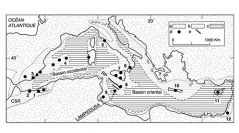

 Geodiversitas
24 (3) - Pages 625-639
Geodiversitas
24 (3) - Pages 625-639In the Sicilian-Tunisian shoal, Central Mediterranean, the Lampedusa Island exhibits a 120 m thick Messinian aggradational carbonate sequence with coral reefs. The lower part was deposited in a ramp or inner platform setting, with abundant reef banks especially southeastward. Depositional environments suggest constant accomodation, with accomodation rises mainly balanced by bioclastic production. The upper part of the sequence was deposited in a shallow water inner reefal platform setting, with coral patches or stacked reefs indicating high frequency rising accomodation events. Finally, the reefal platform was infilled by restricted thrombolitic-stromatolitic deposits. Coral reefs and sequential evolution are very briefly compared with those of other Messinian carbonate deposits of the western Mediterranean.
Messinian, Central Mediterranean, carbonate platform, coral reefs, sequences